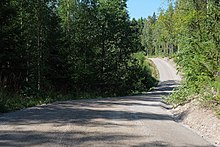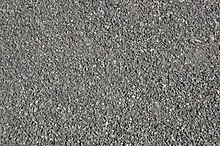Gravel

Gravel (/ˈɡrævəl/) is a loose aggregation of rock fragments. Gravel occurs naturally on Earth as a result of sedimentary and erosive geological processes; it is also produced in large quantities commercially as crushed stone.
Gravel is classified by particle size range and includes size classes from granule- to boulder-sized fragments. In the Udden-Wentworth scale gravel is categorized into granular gravel (2–4 mm or 0.079–0.157 in) and pebble gravel (4–64 mm or 0.2–2.5 in). ISO 14688 grades gravels as fine, medium, and coarse, with ranges 2–6.3 mm (0.079–0.248 in) for fine and 20–63 mm (0.79–2.48 in) for coarse. One cubic metre of gravel typically weighs about 1,800 kg (4,000 lb), or one cubic yard weighs about 3,000 lb (1,400 kg).
Gravel is an important commercial product, with a number of applications. Almost half of all gravel production is used as aggregate for concrete. Much of the rest is used for road construction, either in the road base or as the road surface (with or without asphalt or other binders.) Naturally occurring porous gravel deposits have a high hydraulic conductivity, making them important aquifers.
Definition and properties

Colloquially, the term gravel is often used to describe a mixture of different size pieces of stone mixed with sand and possibly some clay.[1] The American construction industry distinguishes between gravel (a natural material) and crushed stone (produced artificially by mechanical crushing of rock.)[2][3][4]
The technical definition of gravel varies by region and by area of application. Many geologists define gravel simply as loose rounded rock particles over 2 mm (0.079 in) in diameter, without specifying an upper size limit.[5][6][7][8] Gravel is sometimes distinguished from rubble, which is loose rock particles in the same size range but angular in shape.[9] The Udden-Wentworth scale, widely used by geologists in the US, defines granular gravel as particles with a size from 2 to 4 mm (0.079 to 0.157 in) and pebble gravel as particles with a size from 4 to 64 mm (0.16 to 2.52 in). This corresponds to all particles with sizes between coarse sand and cobbles.[10]
The
The bulk density of gravel varies from 1,460 to 1,920 kg/m3 (2,460 to 3,240 lb/cu yd).[14] Natural gravel has a high hydraulic conductivity, sometimes reaching above 1 cm/s.[15]
Origin
Most gravel is derived from disintegration of
Gravel is deposited as gravel blankets or bars in stream channels;
It has been suggested that wind-formed (aeolian) gravel "megaripples" in Argentina have counterparts on the planet Mars.[23]
Production and uses

Gravel is a major basic raw material ·in construction.[24] Sand is not usually distinguished from gravel in official statistics, but crushed stone is treated as a separate category. In 2020, sand and gravel together made up 23% of all industrial mineral production in the U.S., with a total value of about $12.6 billion. Some 960 million tons of construction sand and gravel were produced. This greatly exceeds production of industrial sand and gravel (68 million tons), which is mostly sand rather than gravel.[25]
It is estimated that almost half of construction sand and gravel is used as
Gravel is widely and plentifully distributed, mostly as river deposits, river flood plains, and glacial deposits, so that environmental considerations and quality dictate whether alternatives, such as crushed stone, are more economical. Crushed stone is already displacing natural gravel in the eastern United States, and recycled gravel is also becoming increasingly important.[25]
Etymology
The word gravel comes from the Old French gravele[26] or gravelle.[27]
Types


Different varieties of gravel are distinguished by their composition, origin, and use cases. Types of gravel include:
- Bank gravel
- naturally deposited gravel intermixed with sand or clay found in and next to rivers and streams. Also known as "bank run" or "river run".[28]
- Bench gravel
- a bed of gravel located on the side of a valley above the present stream bottom, indicating the former location of the stream bed when it was at a higher level. The term is most commonly used in Yukon Territory.[29]
- Crushed stone
- rock crushed and graded by screens and then mixed to a blend of stones and fines. It is widely used as a surfacing for roads and driveways, sometimes with tar applied over it. Crushed stone may be made from granite, limestone, dolomite, and other rocks. Also known as "crusher run", DGA (dense grade aggregate) QP (quarry process), and shoulder stone.[30] Crushed stone is distinguished from gravel by the U.S. Geological Survey.[25]
- Fine gravel
- gravel consisting of particles with a diameter of 2 to 6.3 millimetres (0.079 to 0.248 in)[13]
- Lag gravel
- a surface accumulation of coarse gravel produced by the removal of finer particles.
- Pay gravel
- also known as "pay dirt"; a nickname for gravel with a high concentration of gold and other precious metals. The metals are recovered through gold panning.
- Pea gravel
- also known as "pea shingle" is clean gravel similar in size to garden peas.[31]Used for concrete surfaces, walkways, driveways and as a substrate in home aquariums.
- Piedmont gravel
- a coarse gravel carried down from high places by mountain streams and deposited on relatively flat ground, where the water runs more slowly.[32]
- Plateau gravel
- a layer of gravel on a plateau or other region above the height at which stream-terrace gravel is usually found.[33]
- Shingle
- Coarse, loose, well-rounded, waterworn, specifically
Relationship to plant life
In locales where gravelly soil is predominant, plant life is generally more sparse.[35] This is due to the inferior ability of gravels to retain moisture, as well as the corresponding paucity of mineral nutrients, since finer soils that contain such minerals are present in smaller amounts.
In the geologic record
See also
References
- ^ "gravel". Oxford English Dictionary (Online ed.). Oxford University Press. (Subscription or participating institution membership required.)
- S2CID 242973747.
- ^ "The complete guide to crushed stone and gravel". Gra-Rock. 16 June 2020. Retrieved 24 November 2021.
- ^ "Crushed stone vs. gravel". A.L.Blair Construction Ltd. 24 October 2017. Retrieved 24 November 2021.
- ^ ISBN 0922152349.
- ^ ISBN 0716724383.
- ^ ISBN 0131547283.
- ISBN 9780199653065.
- ISBN 0-7167-3905-4.
- .
- ISBN 0136427103.
- ^ ISBN 0136427103.
- ^ a b "ISO 14688-1:2002 – Geotechnical investigation and testing – Identification and classification of soil – Part 1: Identification and description". ISO.
- ISBN 978-0873351003.
- OCLC 4493153.
- ^ Prothero & Schwab 2004, pp. 68–70.
- ^ a b Prothero & Schwab 2004, p. 74.
- ^ ISBN 9781405177832.
- .
- S2CID 129225730.
- .
- S2CID 128550835.
- doi:10.1130/B30916.1.
- ^ a b Bolen, W.P. (2000). "Sand and gravel construction" (PDF). US Geological Survey Minerals Yearbook. Archived from the original (PDF) on 20 October 2021. Retrieved 26 July 2021.
- ^ doi:10.3133/mcs2021.
- ^ Collins English Dictionary – Complete & Unabridged 11th Edition. Retrieved 30 August 2012 from CollinsDictionary.com website:http://www.collinsdictionary.com/dictionary/english/gravel
- ^ Gravel, n., Oxford English Dictionary Second Edition on CD-ROM (v. 4.0) © Oxford University Press 2009
- ^ Jackson 1997, "bank gravel".
- ^ Jackson 1997, "bench gravel".
- ^ "Quarry Process – QP, DGA – NJ, NY, NYC, PA". braenstone.com. Archived from the original on 27 January 2018. Retrieved 1 May 2014.
- ^ Jackson 1997, "pea gravel".
- ^ Jackson 1997, "piedmont gravel".
- ^ Jackson 1997, "plateau gravel".
- ^ Jackson 1997, "shingle".
- ^ C.Michael Hogan. 2010. Abiotic factor. Encyclopedia of Earth. eds Emily Monosson and C. Cleveland. National Council for Science and the Environment Archived 8 June 2013 at the Wayback Machine. Washington DC
External links
![]() Media related to Gravel at Wikimedia Commons
Media related to Gravel at Wikimedia Commons
- Flett, John Smith (1911). . In Chisholm, Hugh (ed.). Encyclopædia Britannica. Vol. 12 (11th ed.). Cambridge University Press. p. 382.
- British Geological Survey UKGravelBarriers: Understanding coastal protection by gravel barriers in a changing climate
